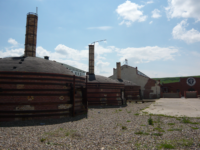Tackling homelessness requires broad-spectrum approach
By Alejandra Pulido-Guzman - Lethbridge Herald on August 18, 2022.
 Herald File photo
Tents continue to fill the grounds next to the Civic Centre track. Homelessness and affordable housing need to be looked at from a broad social infrastructure perspective, says a social technology organization.
Herald File photo
Tents continue to fill the grounds next to the Civic Centre track. Homelessness and affordable housing need to be looked at from a broad social infrastructure perspective, says a social technology organization.LETHBRIDGE HERALDapulido@lethbridgeherald.com
Homelessness and affordable housing need to be looked at from a broad social infrastructure perspective, says HelpSeeker Technologies co-founder and co-president Alina Turner.
The social technology organization, in partnership with Canada Mortgage and Housing Corporation’s (CMHC) Expert Community on Housing (ECOH) offered a webinar on Tuesday about Defining Canada’s Community Housing and Homelessness Continuum through Systems Mapping.
“We need to be thinking from a broader ecosystem perspective not just plan for what we deliver directly or will be funding directly,” said Turner.
She said the idea of creating a housing continuum is difficult due to the lack of consistency in terminology for certain factors that play key roles in the spectrum. She said they do not actually have a good definition of a continuum.
“As somebody who has done the pit count a billion times, too much for my own mental health, I can tell you that when you get into the nitty gritty there is no consistency between what a transitional housing facility is in this community, or that community, and even within the same community there’s inconsistency when it comes to the various features associated with that program type,” said Turner.
She said one of the reasons why that happens is because people tend to confuse the concept of an organization, a program, the concept of a service and the features accordingly.
“So that’s the challenge of mapping systems. We need to first identify these, the data framework through which to collect the data, and analyze the data,” said Turner.
She offered a real world example from an unnamed community they have been working with where concepts like community housing, affordable rental, supportive housing, transitional housing, emergency shelters and homelessness are used.
“If you think about the idea of an emergency shelter and the basic function of that is just a safe place for somebody to stay and the length of stay is short term and it has some supports on site that are meant to help somebody connect to other services,” said Turner.
She then explained that if that same emergency shelter is compared to affordable rental within the same continuum, then it would be represented as affordable by being free when it is related to the affordability of the client. But she said that is not a concept that can be compared as emergency shelter is based on the concept of crisis and not the ownership of the space.
Turner said a continuum implies that it has a consistency of features, but it actually does not apply in this case. Because of this reason the concepts cannot be analyzed very well.
“That gets even more complicated when this community that I’m showcasing here, they’re wanting to create a consistent continuum between affordable housing, homelessness, recovery from addictions and mental health,” said Turner.
She said they are approaching it from the idea of overlapping concepts within the continuum.
The graphic she used of this continuum showcased from left to right homelessness, emergency shelter, transitional housing, supportive housing, community housing, affordable rental, affordable home, and market housing as the main categories.
In between homelessness and transitional housing there was a sub-category called ‘help with addictions’ which had a whole recovery continuum of its own. The categories listed were supervised consumption site, shelter and intox, permanent supportive housing with recovery intervention focus, detox, treatment, recovery housing and post-treatment housing.
“We just went through this process helping Infrastructure Canada with their emergency shelter and transitional housing research this year and saw this first hand,” said Turner.
She said the only way to be able to analyze the data and create a continuum is by using a concept developed by the University of Toronto called Ontology, which refers to a shared understanding of a particular domain through conceptualization, use of explicit definitions and relationships between concepts.
Follow @APulidoHerald on Twitter
20-19



